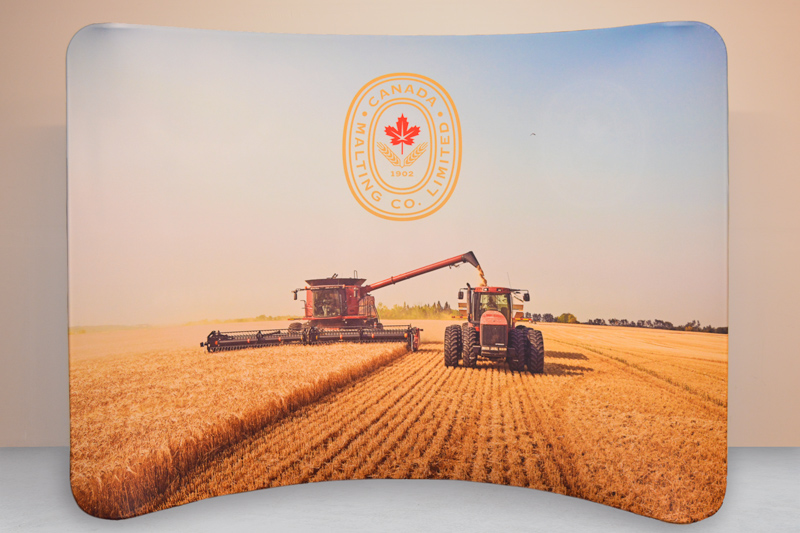
Types Of Displays
Banner Stand: Any graphic display that showcases a vertical graphic “banner” via a hardware framework.
Build & Burn: A term used to describe any display/exhibit designed and built for one-time use.
Custom: A display designed and built to meet the specific needs of an exhibitor.
Double-Decker: An exhibit with an upper deck or second story.
Fabric Display: Refers to the type of portable display where a printed fabric graphic is stretched over the hardware system. May use velcro or zippered closures.
Knockdown (KD): An exhibit with separate components that must be assembled on-site.
Modular: An exhibit constructed with interchangeable components designed to be set up in various configurations and sizes.
Pop-Up Display: Portable display where the framework ‘pops’ up and snaps together, to which graphic panels are attached.
Portable: A term that covers many different types of displays, so long as they are lightweight enough to be moved without a forklift.
Self-Contained: A display which uses the shipping case as an integral part of the exhibit.
Truss: May refer to the overhead hardware above a stage or exhibit, or a modular display where the hardware components include a truss system.
Your Space
Corner Booth: An exhibit space with exposure on at least two aisles.
Cross-Aisle: An aisle at a right angle to a main aisle.
In-Line (or Linear) Booth: Exhibit spaces that are part of the continuous line along an aisle. Neighbouring booth spaces on both the left and right.
Island Booth: Where your booth space is akin to an island; alone with aisles on four sides.
Peninsula: An exhibit space with aisles on three sides—neighbouring booth space on the back.
Perimeter Booth: Any booth space that backs against the building/structural wall of the exhibit hall.
Pipe & Drape: Tubing covered with draped fabric to make up the rails and backwall of a trade show.
Side Rail: A low divider wall, usually pipe and drape, used to divide one exhibit space from another.
Hardwall: A type of exhibit construction in which divider walls are made of a solid material, rather than drape.
Shipping & Storage
Advance Receiving: Location set by show management to receive freight before the start of show. Freight is stored at this location and then shipped to the show at the appropriate time.
CWT: Hundred weight. A measurement used for shipping exhibit properties. Usually 100 pounds.
Material handling/Drayage: The movement of show materials from shipping dock to booth for show set up and back to dock for return shipment at end of show.
I&D: Refers to Installation & Dismantle (of an exhibit). Also known as Setup & Take Down.
Marshaling Yard: A lot where trucks gather for orderly dispatch to show site.
Targeted Move In: A specific day and time that you are scheduled to move your booth into a show hall.
On The Show Floor
Boneyard: A storage area for empty crates and contractor materials.
Exhibitor Appointed Contractor (EAC): A contractor hired by an exhibitor to perform trade show services independently of show management appointed contractors.
Floor Order: Order for services placed after exhibit installation has begun.
Lead Card: A pre-printed piece of paper designed for booth staff to capture lead information on the show floor: contact info, Q&A, notes, etc.
Lead Retrieval: An electronic system used at a trade show to capture lead information. Used in place of Lead Cards.
Swag: Stuff We All Get, or Stuff We All Giveaway. Handout promotional items at a trade show.
Visqueen: A clear plastic sheeting that is placed over exhibit carpeting after its laid in order to protect it until the show opens.
Exhibit Components
Backlighting: Use of a light source to illuminate translucent material from behind.
Electrical: Refers to the ordering and placement of the electrical outlets in your booth space.
Fire Retardant: Term used to describe a finish which coats materials with a fire-resistant (not fire proof) cover.
Foam Core: Rigid foam covered with heavy paper stock used for mounting signs, art, etc.
Header: A sign or other structure across the top of an exhibit.
Rendering: A computer 3D model of an exhibit or display.
Scrim: Fabric which is opaque when lighted from the front and transparent when lighted from the rear.
Sintra: Rigid plastic sheets often used in exhibit construction. Available in a variety of colours. Can be direct-printed or used for mounting graphics.
Throw Cover: Fabric covering for the standard 6′ or 8′ table often offered with a booth space rental. Can be custom printed.
